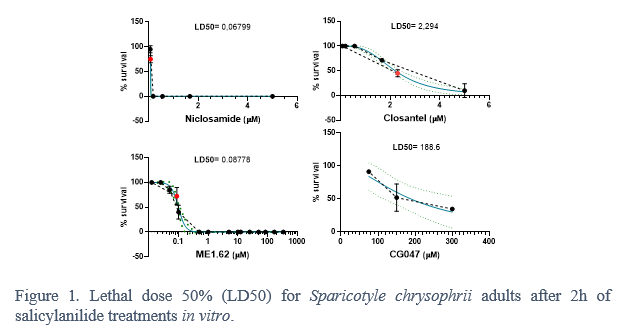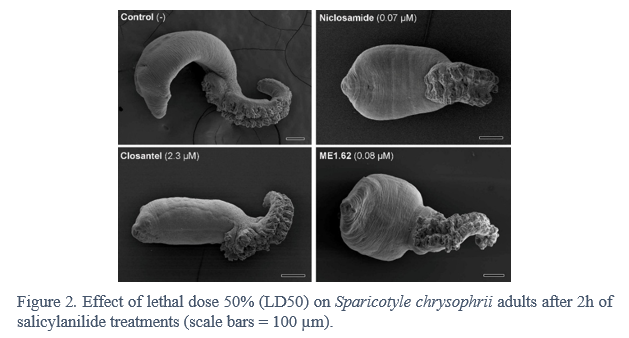SALICYLANILIDES INCLUDE HIGHLY EFFECTIVE CANDIDATE TREATMENTS AGAINST POLYOPISCOTYLEAN GILL PARASITES IN GILTHEAD SEABREAM Sparus aurata
Introduction
The hematophagous ectoparasite Sparicotyle chrysophrii represents a critical health challenge for net-pen aquaculture of gilthead seabream, one of the main fish species cultured across the Mediterranean and the third most produced in Europe. Current treatment options are limited, with formalin baths being the only approved therapy in Western Europe. However, their application in sea cages is logistically complex, costly, and raises environmental, fish welfare, and operating safety concerns. This context highlights the urgent need for effective, safe, and practical in-feed antiparasitic alternatives tailored to the needs of marine aquaculture.
Our work focuses on investigating the mechanisms of action (MOA) of pharmacological active ingredients with potential against polyopisthocotylean infections. Stemming from previous computational virtual screening of chemical libraries for antiparasitic compounds and in vitro studies, several candidate drugs were shortlisted. In this work, we evaluate four drugs belonging to the salicylanilide chemical family: niclosamide , closantel, and their molecular fingerprint compounds ME1.62 and CG047 .
Materials and methods
Adult specimens of S. chrysophrii were obtained from the gills of experimentally infected gilthead seabream. An in vitro dose-response assay was performed to evaluate the survival of parasites exposed to selected pharmacological compounds. The trials were conducted in duplicate, in 24-well plates, with 10 worms per well. Worm s were observed at various times post-exposure (p.e. ) using a binocular microscope, and survival was registered for each of the compounds. Survival data were analyzed using nonlinear regression models fitted to normalized dose-response curves in order to determine the lethal dose 50 (LD50), which is the concentration that results in a 50% mortality rate among the worms. We determined the LD50 at different times p.e., with special focus on the short-term effect (less than 2 hours p.e.).
Moribund or dead worms were fixed for histological examination to assess sublethal effects. We used scanning electron microscopy (SEM) to evaluate the effects of the treatments on the ultrastructure of the parasites’ tegument upon exposure to the LD50_2h (n = 10 specimens/treatment). We also used immuno labelling approaches to investigate the MOA of the drugs at the level of the musculature and cytoskeleton.
Results
Three of the 4 salicylanilides tested resulted highly effective killing the parasites in vitro . According to their LD50 at 2h p.e , they ranked as follows (Figure 1) : niclosamide (0.06792 µM) , ME1.62 (0.08778 µM), closantel (2.294 µM) and CG047 (188.6 µM).
The primary MOA of this chemical family is related to uncoupling of the mitochondrial oxidative phosphorylation and eventually disturbing ATP production. Based on this, morphological analysis of exposed worms revealed an antero-posterior body contraction for the three most effective salicylanilides tested. Examination by SEM evidenced that the severe body contraction affected the surface of the parasites’ tegument, compared to control untreated worms. The tegument formed deep transverse folds and ridges in all parasites exposed to the treatments. The parasite’s haptor, the organ for attachment to the gill filaments provided with two rows of clamps, was also severely affected by the drug treatments. Muscle contraction provoked clamp opening after treatment with closantel and ME1.62 , whereas niclosamide induced clamp opening accompanied by the retraction of the clamps within their tegumental sheaths. Additionally , it caused erosive damage in some tegument areas (Figure 2).
Conclusions
Niclosamide and closantel are routinely used as antihelminthic agents in both human and veterinary medicine, targeting parasite motility and essential physiological processes. This study offers new insights into the mode of action (MOA) of three salicylanilide -based compounds, contributing to a deeper understanding of their efficacy and specific effects on S. chrysophrii . The primary MOA of this pharmacological class is linked to disruption of the parasite’s energy metabolism, which in this study led to severe muscle fiber contraction, resulting in body shortening and clamp opening, ultimately followed by death. The high effectiveness of some tested compounds was particularly noteworthy, with niclosamide and ME1.62 demonstrating efficacy at doses more than 1,000 times lower than praziquantel, a n anthelmintic with known effectivity against polyopisthocotyleans.
Funding
This work was supported by Grant PID2022-136914OB-I00 funded by MICIU/AEI/10.13039/501100011033 and by FEDER, UE.

